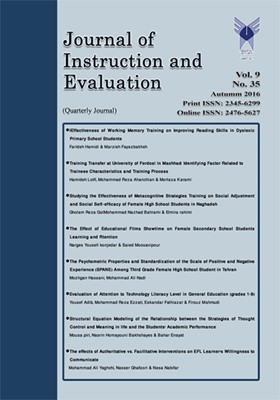اثرات عملکردی نفوذ استاد و عدم نفوذ استاد بر تمایل زبان آموزان به برقراری ارتباط
الموضوعات :محمدعلی یاغچی 1 , ناصر غفوری 2 , نساء نبیفر 3
1 - گروه زبانانگلیسی، واحد تبریز، دانشگاه آزاد اسلامی، تبریز، ایران
2 - گروه زبانانگلیسی، واحد تبریز، دانشگاه آزاد اسلامی، تبریز، ایران
3 - گروه زبانانگلیسی، واحد تبریز، دانشگاه آزاد اسلامی، تبریز، ایران
الکلمات المفتاحية: تمایل به برقراری ارتباط, زبان آموزان, گروه تحت نفوذ استاد, گروه آزاد از نفوذ استاد,
ملخص المقالة :
تحقیق حاضر سعی دارد تا تاثیرات به کارگیری چارچوب نظری نفوذ استاد را در کلاسهای آموزش زبان انگلیسی در دانشگاه فرهنگیان تبریز مورد بررسی قرار دهد، چهارچوبی که جان هرون تحت عنوان "بررسی شش اصل نفوذ استاد بر تمایل زبان آموز به برقراری ارتباط" مطرح کرده است. این مدل که ریشه در نظارت بالینی دارد، می تواند رفتار کلامی و جمله های حقیقی که استاد در بافت یادگیری زبان بکار می برد را جهت دهد. 60 دانشجو در آزمون مهارتهای عمومی زبان PET شرکت کردند که بر اساس نتایج حاصله ، 36 نفراز آنها به دو گروه 18 نفری برای این پژوهش انتخاب شدند. گروه اول، گروه تحت نفوذ استاد بود که در آن استاد تعیین می کرد چه اقداماتی باید صورت پذیرد، این استاد بود که اطلاعات را ارائه می داد و یا با دانشجوها تعامل داشت. گروه دوم، گروه عاری از نفوذ استاد بود که در آن استاد صرفا ایده دهنده، حلال مشکلات و اعتماد به نفس دهنده بود. این دو گروه پرسشنامه های مربوط به تمایل به برقراری ارتباط، هم قبل، هم بعد و هم در دوره پیگری مجدد آموزشی را کامل کردند. نتایج حاصل از بکارگیری شش اصل نفوذ استاد حاکی از تغییرات چشمگیر در عملکرد دانشجویانی داشت کهو تحت نفوذ استاد نبودند و به عملکرد بهتر این گروه ازگروه تحت نفوذ استاد منجر گردید. امید است که این تحقیق افق های روشن جدیدی را به روی متخصصان، اساتید و نیز دانشجویان در حیطه آموزش زبان انگلیسی ایجاد نماید
References
Alemi, M., Tajeddin, Z. & Mesbah Z. (2013). Willingness to communicate in L2 English: Impact of Learner Variables. Journal of Research in Applied Linguistics, 4 (1), 42-61.
Ashmore, R. (1999). Heron’s intervention framework: An introduction and critique. Mental Health Nursing, 19(1), 24-27.
Cao, Y., & Philip J. (2006). Interactional context and willingness to communicate: a comparison of behavior in whole class, group and dyadic interaction. System, 34 (2006), 480-493.
Chambers, M., & Long, A. (1995). Supportive clinical supervision: A crucible for personal and professional change. Journal of Psychiatric and Mental Health Nursing, 2(5), 311-316. http://dx.doi.org/10.1111/j.1365-2850.1995.tb00097.x
Cutcliffe, J., & Epling, M. (1997). An exploration of the use of John Heron’s confronting interventions in clinical supervision: Case studies from practice. Psychiatric Care, 4(4), 174-180.
de Bot, K., Lowie, W., & Verspoor, M. (2005). Second language acquisition: An advanced resource book. USA: Routledge.
Dornyei, Z., & Murphey, T. (2003). Group dynamics in the language classroom. Cambridge: Cambridge University Press. http://dx.doi.org/10.1017/CBO9780511667138
Edwards, A. D., & Westgate, D. P. G. (1987). Investigating classroom talk. London: The Falmer Press.
Ellis, R. (1999). (Ed.). Learning a second language through interaction. Philadeliphia: John Benjamins.
Ellis, R. (2008). The study of second language acquisition(2nd ed.).Oxford: OUP.
Farrell, T. S. C. (2002). Classroom discourse: An introduction. Singapore: National Institute of Education, Nanyang Technological University.
Fowler, J. (1996). Clinical supervision: What do you do after you say hello? British Journal of Nursing, 5(6), 382-385. http://dx.doi.org/10.12968/bjon.1996.5.6.382
Galadja, D. (2012). Teacher’s zone of action in facilitating group dynamics. LINGVARM ARENA, 3, 89-101.
Heron, J. (1976). A six-category intervention analysis. British Journal of Guidance and Counseling, 4(2), 143-155. http://dx.doi.org/10.1080/03069887608256308
Heron, J. (2001). Helping the client: A creative practical guide (5th ed.). London: Sage Publication.
Lai, W. (2012). Concept-based foreign language pedagogy: Teaching the Chinese temporal system (Unpublished Ph.D. dissertation, The Pennsylvania State University, University Park, PA).
Lantolf, J. P., & Thorne, S. (2006). Sociocultural theory and the genesis of second language development. Oxford: Oxford University Press. www.ccsenet.org/ijel International Journal of English Linguistics, 6(1), 2016 98.
Larsen-Freeman, D. (1997). Chaos/complexity science and second language acquisition. Applied Linguistics, 18(2), 141-165.
Larsen-Freeman, D., & Cameron, L. (2008). Complex systems and applied linguistics. Oxford: Oxford University Press.
Lengeling, M. M. (2011). Past, present, and future of second language acquisition: An interview with Rod Ellis. MEXTESOL Journal, 35(1), 1-7.
MacIntyre, P.D., Burns, C., & Jessome, A. (2011). Ambivalence about communicating in a second language: a qualitative study of French immersion learners' willingness to communicate. The Modern Language Journal, 95 (1) (2011), 81-96.
Maggioli, G. E. (2012). Teaching language teachers: Scaffolding professional learning. UK: Rowman and Littlefield.
Negueruela, E., & Lantolf, J. P. (2006). Concept-based pedagogy and the acquisition of L2 Spanish. In R. M. Salaberry & B. A. Lafford (Eds.), The art of teaching Spanish: Second language acquisition from research to praxis(pp. 79-102). Washington: Georgetown University Press.
Sloan, G., & Watson, H. (2001). John Heron’s Six Category Intervention Analysis: Towards understanding interpersonal relations and progressing the delivery of clinical supervision for mental health nursing in the United Kingdom. Journal of Advanced Nursing, 36(2), 206-214. http://dx.doi.org/10.1046/j.1365-2648.2001.01961.x
Sloan, G., & Watson, H. (2002). Clinical supervision models for nursing: Structure, research and limitations. Nursing Standard, 17(4), 41-46. http://dx.doi.org/10.7748/ns2002.10.17.4.41.c3279
Swain, M. (2000). The output hypothesis and beyond: Mediating acquisition through collaborative dialogue. In J. Lantolf (Ed.), Socio-cultural theory and second language learning (pp. 97-114). Oxford: Oxford University Press.
Van Compernolle, R. A. (2011). Developing second language sociopragmatic knowledge through concept-based instruction: A mictrogenetic case study. Journal of pragmatics, 43, 3268-3283. doi:10.1016/ j.pragma.2011.06.009
Vygotsky, L. S. (1986). Thought and language. Cambridge, MA: MIT Press.
Wen, W.P. and Clement, R. (2003) A Chinese conceptualization of willingness to communicate in ESL. Language, Culture and Curriculum, 16 (1) (2003), 18-38.
Widdowson, H. G. (1990). Aspects of language teaching. Oxford: Oxford University Press.
_||_

